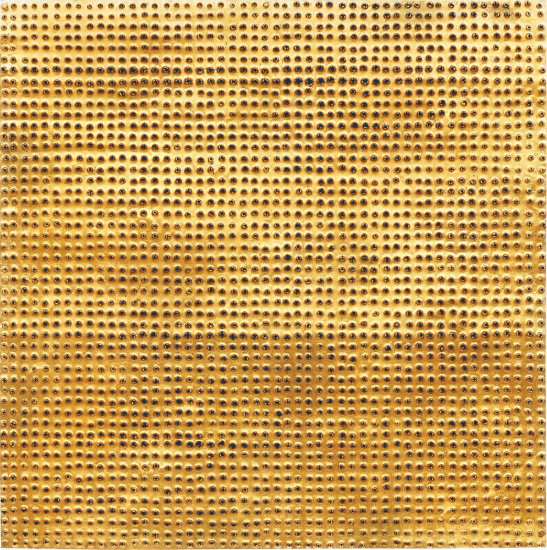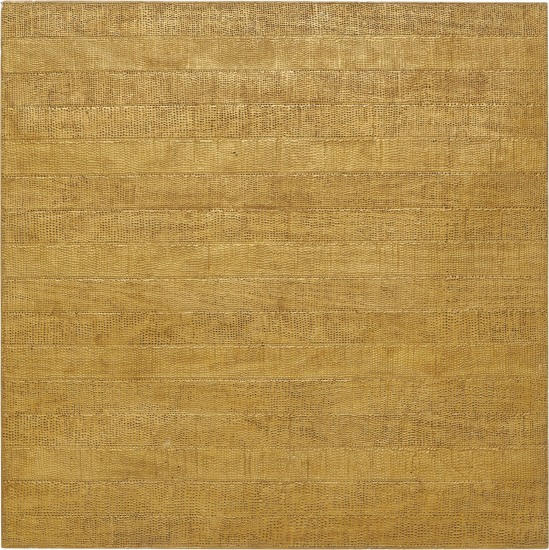27 Mathias Goeritz Mensaje 1959 goldleaf on wood 53 1/8 x 48 x 2 in. (134.9 x 121.9 x 5.1 cm) This work is accompanied by a certificate of authenticity signed by Lily Kassner.
Provenance Collection of Casa Prieto - López, Mexico City Christie's, New York, Latin American Sale Evening Session, May 28, 2008, lot 28 Acquired from the above sale by the present owner Exhibited Madrid, Museo Nacional Centro de Arte Reina Sofia, The return of the snake: Mathias Goeritz and the invention of emotional architecture, November 11, 2014 - April 13, 2015 Literature The return of the snake: Mathias Goeritz and the Invention of Emotional Architecture, exh. cat., Museo Nacional Centro de Arte Reina Sofia, Madrid, 2014 - 2015, p.111 (illustrated) Catalogue Essay When he moved to Mexico in 1949, Mathias Goeritz brought with him a knowledge of the many European artistic tendencies of the time epitomized by established artists such as Yves Klein Otto Pienne, Heinz Mack and Paul Klee who were both his friends and influencers. In Europe, Goeritz had been fascinated with the artistic avant-garde and the role of abstraction within modern art. By the time he left the continent, he had already built a career for himself as a cultural promoter and a truly modern artist and architect. The transference of this knowledge and the opening of Mexico to the larger international art world was one of his great contributions to Mexican art. He considered this influence to be what he called “a function of legitimization of recycling,” (Museo Nacional Centro de Arte Reina Sofía, El Retorno de la Serpiente—Mathias Goeritz—la Invención de la Arquitectura Emocional, Madrid, 2015, p. 80). Goeritz and these artists were deeply interested in painting and architecture, with a permanent interest in the way a line yearns to become a plane and a plane yearns to become a space. This led to the development of the concept of emotional architecture, which proposed that architecture should not be reduced to the dominant importance of functionality and should rather engage humankind with its beauty, creating an emotional response. In Mexico, Goeritz implemented this conceptualization in collaboration with the renowned Mexican architect, Luis Barragán who he met shortly after arriving in the country and with whom he instantly initiated a rich collaboration and friendship. During this time Barragán developed what is considered one of the most important architectural projects of Mexico in the 1940s and 1950s, the real estate project, El Pedregal, where he commissioned Goeritz to create the concrete sculpture known as the Serpiente del Pedregal. This commission lead to many more and resulted in the publication of Goeritz’s famous Manifiesto de Arquitectura Emocional in the prestigious art magazine, Zero, in 1954. His manifesto was emblematized by the innovative monumental construction of the Torres Satélite, 1957-1958. His collaboration with Barragán spanned a period of 18 years, during which time the two would create a variety of works together that would also reflect the different periods within Goeritz’s oeuvre. Shortly after the Torres Satélite and following the death of his former wife, Marianne Gast, Goeritz entered a deep depression that profoundly affected his artistic production. During this period of mourning he began working on a series of works entitled Mensajes (Messages). This was a new series of non-figurative works that was drastically different from any of the work he had done before, and Mensaje, c. 1960 is a prime example. All Mensajes are monochromatic and are covered in carefully applied gold leaf or puncture gold metal. The present is a particularly important example as it was part of another fruitful collaboration with Barragán. This particular type of Mensaje belongs to a group that Goeritz himself called “decorative” as they were created for specific houses in collaboration with prominent architects. They were purposefully simplified without clouage, or punctured metal, and fully covered in gold leaf. This work was commissioned for another monumental architectural project by Luis Barragán called the Casa Prieto-Lopez, part of the J
27 Mathias Goeritz Mensaje 1959 goldleaf on wood 53 1/8 x 48 x 2 in. (134.9 x 121.9 x 5.1 cm) This work is accompanied by a certificate of authenticity signed by Lily Kassner.
Provenance Collection of Casa Prieto - López, Mexico City Christie's, New York, Latin American Sale Evening Session, May 28, 2008, lot 28 Acquired from the above sale by the present owner Exhibited Madrid, Museo Nacional Centro de Arte Reina Sofia, The return of the snake: Mathias Goeritz and the invention of emotional architecture, November 11, 2014 - April 13, 2015 Literature The return of the snake: Mathias Goeritz and the Invention of Emotional Architecture, exh. cat., Museo Nacional Centro de Arte Reina Sofia, Madrid, 2014 - 2015, p.111 (illustrated) Catalogue Essay When he moved to Mexico in 1949, Mathias Goeritz brought with him a knowledge of the many European artistic tendencies of the time epitomized by established artists such as Yves Klein Otto Pienne, Heinz Mack and Paul Klee who were both his friends and influencers. In Europe, Goeritz had been fascinated with the artistic avant-garde and the role of abstraction within modern art. By the time he left the continent, he had already built a career for himself as a cultural promoter and a truly modern artist and architect. The transference of this knowledge and the opening of Mexico to the larger international art world was one of his great contributions to Mexican art. He considered this influence to be what he called “a function of legitimization of recycling,” (Museo Nacional Centro de Arte Reina Sofía, El Retorno de la Serpiente—Mathias Goeritz—la Invención de la Arquitectura Emocional, Madrid, 2015, p. 80). Goeritz and these artists were deeply interested in painting and architecture, with a permanent interest in the way a line yearns to become a plane and a plane yearns to become a space. This led to the development of the concept of emotional architecture, which proposed that architecture should not be reduced to the dominant importance of functionality and should rather engage humankind with its beauty, creating an emotional response. In Mexico, Goeritz implemented this conceptualization in collaboration with the renowned Mexican architect, Luis Barragán who he met shortly after arriving in the country and with whom he instantly initiated a rich collaboration and friendship. During this time Barragán developed what is considered one of the most important architectural projects of Mexico in the 1940s and 1950s, the real estate project, El Pedregal, where he commissioned Goeritz to create the concrete sculpture known as the Serpiente del Pedregal. This commission lead to many more and resulted in the publication of Goeritz’s famous Manifiesto de Arquitectura Emocional in the prestigious art magazine, Zero, in 1954. His manifesto was emblematized by the innovative monumental construction of the Torres Satélite, 1957-1958. His collaboration with Barragán spanned a period of 18 years, during which time the two would create a variety of works together that would also reflect the different periods within Goeritz’s oeuvre. Shortly after the Torres Satélite and following the death of his former wife, Marianne Gast, Goeritz entered a deep depression that profoundly affected his artistic production. During this period of mourning he began working on a series of works entitled Mensajes (Messages). This was a new series of non-figurative works that was drastically different from any of the work he had done before, and Mensaje, c. 1960 is a prime example. All Mensajes are monochromatic and are covered in carefully applied gold leaf or puncture gold metal. The present is a particularly important example as it was part of another fruitful collaboration with Barragán. This particular type of Mensaje belongs to a group that Goeritz himself called “decorative” as they were created for specific houses in collaboration with prominent architects. They were purposefully simplified without clouage, or punctured metal, and fully covered in gold leaf. This work was commissioned for another monumental architectural project by Luis Barragán called the Casa Prieto-Lopez, part of the J










.jpg)




Try LotSearch and its premium features for 7 days - without any costs!
Be notified automatically about new items in upcoming auctions.
Create an alert